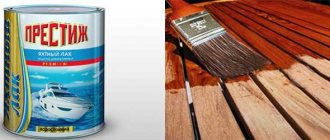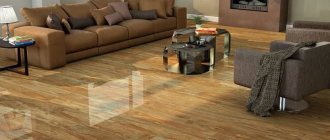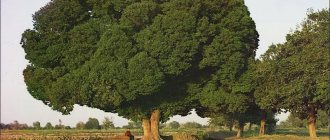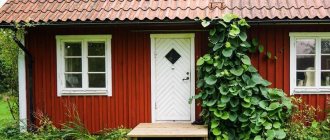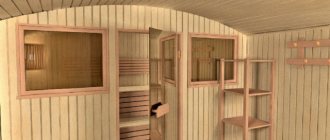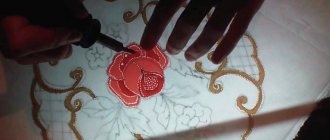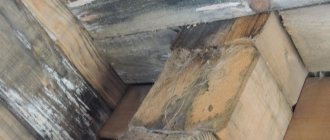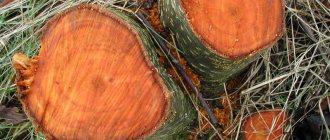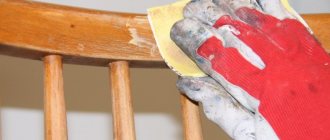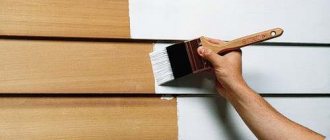Are you planning to coat the wood with yacht varnish? Find out more about how to properly work with this composition. Yacht varnish was originally intended for the exterior decoration of sea and river vessels. The material is characterized by excellent water resistance and chemical resistance. Today, varnish is widely used in everyday life: it is used to cover wooden windows, doors, terraces, street structures, etc. However, this is not as safe as it seems at first glance. When using ship convoys for everyday use, you should strictly adhere to the instructions.
Yacht varnish contains quite aggressive substances - toluene and xylene. These are volatile compounds that have a negative effect on the body. It is unacceptable to use ship varnishes for interior decoration! When painting wood outdoors, toxic components erode very quickly, so they will not cause harm to humans.
Properties and chemical composition
The main purpose of varnish is to protect wood from the negative effects of external factors. Therefore, special substances are introduced into its composition to ensure such properties at a sufficient level. To obtain high water resistance, the product contains xylene, toluene or other toxic benzene compounds. It is because of them that the varnish cannot be used indoors, although as it evaporates, the coating becomes safe for the body. The main component of yacht varnish can be various polymers - alkyds (synthetic resins based on phthalic acid), urethanes, etc.
The concept of “yacht varnish” or “deck varnish” is applicable to all products that are characterized by increased weather resistance and are intended for wooden products. Materials of this group are characterized by the following properties:
- High adhesion to the base. The varnish film adheres reliably to the surface, does not peel off or crack over time.
- Strength and hardness. Thanks to these qualities, the varnish does not react to scratches, is not damaged by other types of mechanical stress and has a long service life.
- Elasticity. After drying, the material is able to move to some extent following changes in the position of the substrate. This property helps the varnish film not to crack or peel even with severe shrinkage of the wood.
- Abrasion resistance. Yacht varnish is resistant to abrasion because it has good ductility and tensile strength.
- Moisture resistance. The film repels water, protects wood from getting wet and swelling, and prevents putrefaction and mold.
- Counteracting microorganisms. Thanks to the varnish coating, the underwater part of the ships does not become overgrown with algae, fungal colonies, and other aquatic organisms do not settle on it. This helps save fuel and extend the life of the wood. This property is achieved by introducing into the composition biocides that are not washed out by water and do not dissolve in it.
- UV resistance. The varnish includes additives that absorb ultraviolet radiation and transform it into thermal energy. The composition also contains light stabilizers (amines) that bind free radicals and prevent the latter from destroying the varnish film.
Insecticides are often introduced into household products that are used to protect furniture and other household items. They prevent the appearance of flies, other insects and the proliferation of larvae in the wood.
Polyurethane mixtures
Polyurethane varnishes, paints, primers, adhesives, etc. contain polyurethane - a modern polymer. The totality of its properties surpasses such well-known materials as rubber, plastic, rubber, and metal. To obtain high-strength paint and adhesive solutions, in industrial production it (polyurethane) is mixed with special chemicals.
A lot of polyurethane varnishes are also water-based. This parquet chemistry is environmentally friendly and non-toxic.
If it is necessary to make the substance more liquid, you can use the following as a diluent for polyurethane compounds:
- toluene;
- xylene;
- acetone;
- eluents such as R-4, R-5.
It is not recommended to add alcohols, water, or type 646 eluents.
Acetone is a good thinner for polyurethane varnishes.
Areas of use
Yacht varnish is ideal for processing boats, boats, and other wooden vessels, both externally and internally. In everyday life, it is also very popular and is used to protect wooden and wood-based materials that are used in difficult weather conditions. The following products are treated with ship varnish:
- wooden furniture;
- garden structures;
- fences;
- house facades;
- load-bearing structures of attics, gazebos;
- benches, wooden figures;
- windows and doors;
- components of frame buildings.
Despite the presence of harmful substances, yacht varnish is often used to protect wood flooring to make it resistant to scratches and abrasion. Please note that during drying, living indoors is strictly contraindicated; all yacht varnishes are toxic!
Yacht alkyd urethane varnish
Parade L20 Yachts & boats glossy
One-component alkyd-urethane varnish. First of all, I would like to note the exceptional resistance to external influences and good protective properties. It works especially well on wooden surfaces that are used in unfavorable climate conditions.
The degree of gloss can vary and can be matte, semi-matte and glossy. GOST allows the use of paint in children's institutions, as well as health care facilities.
White spirit is used as a thinner. Stored in a tightly closed container. The cost of the can is 2850 rubles.
Among other advantages I would like to note:
- resistance to shock, sea water, ultraviolet rays and various temperatures;
- creating a durable coating.
Minuses:
- demanding of accommodation conditions. Do not place near sources of heat and fire;
- assumes storage only in original containers.
Yacht varnish Premia
Eco-friendly acrylic paint. After drying, it forms a durable and reliable layer that can be washed. I recommend using this material to create a cozy design in rooms where heavy traffic is expected. According to the description on the manufacturer's website, it can withstand 50,000 brush passes. Used for medical institutions, sports and children's institutions.
The paint is intended for use on brick, plasterboard, plastered and concrete surfaces. These can be walls covered with putty, as well as wallpaper for painting. It can also be applied to an old layer of water-dispersion paint if you prepare the surface in advance. The cost of a 9 liter bucket of paint is 1000 rubles.
Advantages:
- wide range of colors;
- frost resistance. Can withstand up to 50 cycles of short-term freezing and thawing during transportation;
- hiding power. This quality allows you to use less material and save time required for painting;
- environmental Safety.
Minuses:
not detected.
Types and best brands
Depending on the degree of light reflection, varnishes are divided into the following types:
- glossy - perfectly reflect the light flux, look beautiful, but require special care and careful preparation of the surface before application;
- semi-gloss and semi-matte - reflect light worse, have a moderate shine;
- matte - practically do not shine, mask dirt well, visually hide defects and unevenness of the base.
In addition, all varnishes are classified depending on the main chemical that is included in their composition, into alkyd, urethane-alkyd, alkyd-urethane and polyurethane.
Alkyd varnish
This ship varnish contains the most toxic compound - benzene, and therefore can only be used for external use. Benzene vapors are released even after the varnish film has hardened, affecting the human body for several months. Alkyd varnishes are used to coat wooden fences, roofs, and the outside of gazebos. Under moderate mechanical and physical loads, the coating lasts about five years.
Alpina Yachtlack
This is a product of joint Russian-German production, characterized by high quality. It contains not only alkyds, but also polyurethane additives that enhance elasticity, resistance to weathering and aggressive factors. The varnish is used to treat the underwater and surface parts of ships. The advantages of the composition are obvious:
- high shockproof and protective properties;
- resistance to abrasion and scratching;
- beautiful gloss without yellowness.
The product dries for a long time (up to 3 days), while emits a persistent unpleasant odor. If it comes into contact with the skin, it may cause dryness and cracking.
Belinka Yacht
Varnishes of this brand are presented in different variations according to the type of light reflection - matte, semi-matte, glossy, and the cost of matte products is much higher. The products are easy to apply due to their liquid texture; they are quickly absorbed into the wood without changing its shade or causing yellowing. Varnishes are characterized by resistance to mechanical stress and excellent tolerance to fresh and salt water. The disadvantage is the high consumption (100-180 g/sq. m) and the need to apply in 3-4 layers.
Urethane-alkyd varnish
The composition of this varnish reduces the amount of alkyds due to the addition of plasticizing substances (urethanes). They are harmless to health as they do not emit toxins. Thanks to the change in composition, urethane-alkyd varnishes are suitable for interior woodwork, of course, with strict adherence to safety measures. The hardened film does not react to aggressive climatic factors, precipitation, or temperature changes, maintaining protection for up to 10 years. The varnishes are not afraid of heat, so after drying they are suitable even for heated floor coverings.
Premia
The composition is produced in Russia (“Yaroslavl paints”). It dries quickly, protects wood from ultraviolet radiation, and does not leave streaks after hardening. The material is resistant to salt water, has low consumption (75-100 ml/sq. m), and is suitable for manual and mechanized application. Available in glossy, semi-gloss, matte. The downside is the high price.
Eskaro Marine Lakk 90
The varnish is produced in Estonia and has a gel-like consistency. It can be applied without removing old coatings. After drying, it gives a gloss that emphasizes the beauty of the wood. Suitable for exterior and interior use, resistant to cracks and abrasion, although not suitable for floor coverings. The finished film can be washed using household chemicals. Disadvantages: the need to apply three layers (otherwise the strength will be insufficient), average coverage, high price.
Alkyd-urethane varnish
This type of varnish is considered the most popular for exterior woodwork. In the composition of alkyd-urethane products, only one part of the alkyds is replaced with urethanes, so they remain highly toxic. However, the wear resistance of the materials increases, as does moisture resistance and resistance to alkalis. To optimize technical properties, antioxidants and drier are introduced into alkyd-urethane varnishes.
Poli-R
Due to the presence of a large number of UV filters, this varnish practically does not react to solar radiation. The product has a unique property - it can smooth out uneven wood, so it will be easier to care for the product. The advantages of varnish are:
- low consumption, low price;
- no stickiness after drying;
- application without smudges or streaks;
- thick texture, can be diluted with a solvent;
- long service life (9 years).
Unfortunately, the varnish may turn yellow over time, and its smell will only dissipate after a few days.
"Rainbow-Maler"
The varnish is characterized by maximum moisture resistance, reliable adhesion to the substrate, and resistance to temperature changes. It is quite thick, does not flow even on vertical bases, and does not emit a pungent odor, which makes it very different from its “brothers”. The product emphasizes the grain of the wood, dries quickly (within 24 hours), does not crack or fade. To fully protect the wood, you need to apply 3-4 layers of varnish, and its consumption is quite large.
Maxima Yacht Varnish
This product, unlike standard yacht varnishes, has little water resistance, so it is used only for treating the surface of ships. Its most common use is in hot climates to protect domestic and industrial wooden structures. Due to its low odor, the varnish is suitable even for interior work. Its advantages are:
- applied in any way;
- has a matte appearance;
- easily diluted with solvent;
- contains powerful UV filters;
- has a minimum flow rate (about 60 ml/sq. m);
- Dries to touch in just 3 hours.
Polyurethane varnish
The basis of such varnishes are polyurethane resins, which are characterized by elasticity, strength, and wear resistance. Due to their high adhesion, they reliably adhere even to smooth substrates. Some products are polyurethane-acrylic: acrylate resins are added to them, and such varnishes can boast of being odorless and safe for humans.
Johnstones Yacht Varnish
The English composition for external use is suitable not only for wood, but also for stone, brick, and other facade materials. Like other yacht varnishes, it creates a durable elastic film that does not deteriorate from mechanical influences, temperature changes, or UV radiation. The product is especially resistant to abrasion and impact loads, and dries in 2-4 hours. Disadvantages: high cost, presence of large amounts of organic solvents, harmfulness.
"Rolax"
Ukrainian yacht varnish for wood and metal with the addition of antifungal components. Stops rotting processes in wood, extends its service life, and has a low consumption of about 80 ml/sq. m. Applies without streaks, does not flow, and gives an almost mirror-like shine. Cons: unpleasant smell, long drying time.
Symphony Hardwood
This product differs from its analogues in that it takes a very long time to dry – up to 14 days. This feature is due to the presence of special additives in the composition that provide unique moisture resistance. The coating does not deteriorate even from continuous exposure to water for up to 7 days. Typically the composition is used for household purposes. It can be applied directly to old coatings, can be tinted (if necessary), is easy to thin, and has high weather resistance. Available in glossy and silky matte versions.
Bitumen mixtures
Bituminous varnish is a mixture of a special grade of bitumen, various resins and oils. After drying, a durable black film is formed on the surface, moisture-resistant and impervious to chemical attack. It is considered a fairly new material in household use. Belongs to the inexpensive category. It is often used as an anti-corrosion protective layer.
For wooden surfaces it is used when there is no need to emphasize the natural texture of the base (instead of paints). Bituminous material has found application as a decorative coating for the effect of aging surfaces (patina). Another unique feature of bitumen mixtures is cold gluing. The bitumen solution is diluted with white spirit.
To prevent it from thickening during storage, the container must be airtight. The storage location should be dark (without direct sunlight), with moderate temperature and humidity.
Bituminous varnish protects the surface very well from moisture and chemical influences, diluted with white spirit
Advantages and disadvantages
The use of yacht varnishes has many advantages, making the compositions in demand in a variety of industries. Here are the main advantages of the funds:
- excellent compatibility with wood, reliable adhesion to any lumber and wood chips;
- rapid impregnation of the base and long-term presence in its structure;
- not susceptible to sunlight, no fading or destruction;
- repels water, prevents rotting and mold;
- high aesthetic appeal, well-groomed appearance of the product;
- prevention of chips, scratches, damage from chemicals - alkalis, salts, acids;
- relatively low processing cost, economical.
The disadvantages are associated with the presence of harmful substances in the composition. Organic solvents are toxic and have a detrimental effect on human health. As a result, the scope of use of special equipment remains limited.
If the wood was wet, the degree of protection from varnishing is sharply reduced, so ship varnishes are not suitable for products made from fresh wood. Many products do not tolerate frost and become fragile.
Notes on possible harm
However, despite many positive qualities, the compositions also have negative aspects: toxic substances are added to them - toluene and xylene. The first, endowed with carbon and hydrogen, during its evaporation has a bad effect on the body, contributing to the appearance of irritation of the mucous membrane and dizziness. Evaporation usually occurs quite slowly, so the negative effect also lasts for at least a long time.
The second toxin is complex benzene in its pure form, which can easily end up in the human body not only when a person breathes. It can also penetrate the skin. Xylene is often responsible for a large number of internal diseases, which include nervous system disorders.
Knowing all the shortcomings, we can conclude that yacht varnish should not be used as an interior product in order to avoid health problems. It will be much better if the product acts as a protector of wood from the outside of the building.
Packing methods
Most often, varnishes are sold in cans, for application of which you need to buy brushes or rollers. They can have a large volume, which is convenient for varnishing large surfaces. Manufacturers also make products in aerosol form, packaged in cans. They are easy to use and practical, although their price is much higher.
How to apply yacht varnish to wood: stages of work
Wooden products that will be varnished must be absolutely dry: residual humidity no more than 20%. There is no point in processing fresh wood. It is necessary to carefully prepare the surface: sand to remove remnants of the previous coating, remove dirt, mold, fungus from the wood, or bring new wood to a smooth state.
This stage of work will improve the adhesion of the varnish coating to the wood.
The entire area must be primed or completely covered with a special porosity-filling compound. This stage of work will improve the adhesion of the varnish coating to the wood.
When re-processing wooden elements, it is recommended to apply a control coating on an inconspicuous place. This will allow you to check the compatibility of coating materials. Varnish is applied to wood manually with a brush or roller, or using a spray gun. The ambient temperature during painting work should vary from 15 degrees to 35 degrees.
Advice: thoroughly stirring the varnish before using it to process products will avoid delamination in the future and increase its service life.
When covering in several layers, you should take into account how long it takes for yacht varnish for wood to dry. The next layer is applied after the previous one has dried - after 2-6 hours. A more precise drying time is indicated by the manufacturer in the instructions for use. Each layer, after complete drying, can be treated with fine sandpaper to achieve a more durable coating. If the floor is varnished, it will be ready for use only after 7 days, when the varnish coating has completely hardened.
How to dilute yacht varnish on wood if it has thickened? The practicality of using this coating is that it is diluted with ordinary water if it is an alkyd composition. Other types are diluted with various solvents, for example, turpentine, white spirit. After reaching the required consistency, you can again use the material to process wooden parts.
The varnish is packaged in liquid form in jars, and in aerosol form in cans. This paint and varnish material lends itself well to tinting, which significantly expands the range of its use. It is possible to select different colors for individual interiors.
Many well-known manufacturers of paints and varnishes are engaged in the production of yacht varnishes. Yacht varnish for interior woodwork "Tikkurila" is used when processing floors, doors, window frames, and various furniture. It is available in three types: glossy, semi-gloss and matte. The first option is made on the basis of acrylic, the others are made from urethane-alkyd composition. The drying time of the composition is about 6 hours. Resistant to weathering and moisture, it contains components that slow down the effect of sunlight on the color of wood. The consumption of yacht varnish per 1m2 on wood is 0.07-0.08 liters.
But to achieve a good quality varnish layer, you need to take the work seriously:
- If you need to varnish a surface that has previously been varnished, then the previous layer of varnish must be removed. Otherwise, the newly applied layer may swell and crack.
- Before first use, the wood must be dried until its moisture content reaches no more than 20%.
- It is advisable to treat the pre-dried surface with a primer that contains antiseptic additives.
- To create a durable varnish layer, the surface must be treated by applying 2-3 layers of varnish. For application you can use a brush or roller.
- The first layer of varnish is applied along the wood fibers. The next layer is applied only after the previous one has completely dried in the direction across the fibers.
- The time interval between applying the first and second layers can be 5-6 hours, and between the second and third – already 24 hours.
- If you need to give the surface a certain tone, then use a color that is compatible with the composition of the varnish.
- You can use the premises after two days.
Recommendations for selection
Before purchasing varnish, you need to decide in advance about its purpose. If the work is carried out in air, you can choose an alkyd or alkyd-urethane composition. For interior work, it is recommended to buy urethane-alkyd varnish. The type of surface being treated also affects the choice of composition. Thus, polyurethane-acrylic products are suitable for home furniture made of natural wood, alkyd and their derivatives are suitable for garden benches, gazebos, and swings.
It is better to treat a wood floor with high-quality urethane-alkyd marine varnish, while carefully ventilating the room. Glossy coatings look more festive and attractive, matte ones look stylish and elegant. If you need a varnish with maximum moisture resistance, you should pay attention to the brands Belinka, Alpina, Eskaro.
Dilute, dilute or dissolve
At first glance, there is no difference. Using a special tool, we bring the varnish substance into “working condition”. A solvent is a liquid that dissolves dried varnish, bringing it from a solid to a liquid state. We use a thinner if we need to change (reduce) the viscosity of paints.
Some types of organic eluents perform both roles, but some may be effective in one task and completely useless in another. For example, white spirit can be used to dilute compositions of polyurethane, alkyd and oil groups. But if the varnish has dried, it will not be possible to dissolve it with white spirit.
White spirit can be used to thin some varnishes.
But shellacs, on the contrary, are equally dissolved and diluted with denatured alcohols. But let's not go into such subtle details.
If you need advice on what to thin varnish or what to use for thinning paints, it is better to consult with specialists in this field.
We propose to consider in detail which solvents need to be used in specific cases.
Application instructions
Work indoors or outdoors can only be done at positive temperatures, with the optimal range being +15…+30 degrees. Humidity during application should not exceed 80%.
How to determine solution consumption
Usually the exact consumption of the substance is indicated by the manufacturer on the packaging. The standard flow rate is 60-130 ml/sq.m. m. This figure may vary depending on the following factors:
- quality of grinding - the higher it is, the less composition is consumed;
- type of material - porous species (walnut, ash) require more product;
- viscosity - less liquid varnish is needed than thick varnish;
- tools for application - a spray gun will use less varnish than hand tools.
Selecting Tools
To apply the special product, tools are required, and only compositions in cans are applied by conventional spraying.
Brush
This is a simple and affordable tool for painting work. It can have synthetic or natural bristles of different lengths. If the bristles are natural, you will have to wring out the brush often when working, because it tends to accumulate liquid. Artificial materials provide a smoother and more even finish, are resistant to wear and are better suited for outdoor use.
Roller
Rollers are ideal for large areas. You need to purchase tools with short pile that do not cause drips or become deformed. To make the film more uniform and dense, it is worth buying small rollers. Large products are used to process facades.
Spray gun
This handy device is great for varnishing surfaces, especially in hard-to-reach places. The composition is applied by spraying, resulting in a beautiful, uniform, high-quality coating.
Wood preparation
Varnishing should begin by preparing the wood. If its humidity is above 20%, the material must be dried with a construction hairdryer or in special chambers. Next, clean the product from dirt, dust, any stains and grease. Sand the base using sandpaper or a grinding machine. Remove areas of mold and mildew and treat them with an antiseptic.
Primer
To reduce the porosity of wood, it is primed with a special pore-filling primer. Among other things, it will improve the adhesion of the special composition to the substrate and reduce its consumption. After priming, a small area of the product is varnished: if the wood continues to absorb the varnish strongly, apply another layer of primer.
Varnish coating
After opening the can, mix the composition with a wooden spatula, which will prevent delamination. If the mass is too thick, add a solvent - solvent, white spirit, turpentine. Each layer should dry for 2-6 hours (the exact time is indicated in the instructions), after which it is sanded and a new layer is applied. Then the film is allowed to dry completely.
No. 1. What are the differences between different wood varnishes?
Varnish is a viscous product consisting of a solvent, resins and polymers. After application to the surface, the solvent evaporates, leaving a dense, durable film. This barrier protects the tree from various kinds of negative factors. Since wood was previously the main building material, the first varnishes appeared in the 12th century. It was the invention of a German monk, and the composition of the protective substance was kept secret for a long time. Attempts to develop a means to extend the life of wood have been made constantly. Thus, in the 15th century, oil-type compositions appeared in England, and later in Holland and Portugal they began to produce resin-based varnishes.
Since then, the range of such products has expanded significantly, compositions with specific properties have appeared, so today you can’t just go to the store and buy the first wood varnish you come across - it is important to take into account a lot of nuances of different compositions, otherwise you may not only fail to protect the material, but also harm it
When choosing a wood varnish, you should take into account the following factors:
terms of Use. Outdoors, the material is affected by factors such as high humidity, constant temperature changes and ultraviolet radiation, so the composition for protection must be selected accordingly - only wood varnishes are suitable for outdoor use. As a rule, the manufacturer indicates on the packaging the conditions under which the composition can be used. Parquet, furniture and wall finishing materials can be safely coated with wood varnish for interior work;
wear resistance. It is not always possible to cover the floor with the same composition as the furniture, since the load on the surface will be completely different. If even the least resistant nitrocellulose varnish is suitable for furniture and other wooden objects that are not subject to heavy wear, then for flooring it is necessary to take more durable compounds;
toxicity. Most modern formulations have an unpleasant, pungent odor when drying, as they contain organic solvents. Of course, this smell will disappear when the varnish is completely dry, but until then you will, at best, have a headache, and at worst, get serious poisoning. Polyurethane, acrylic, polyester varnishes and nitro varnishes are applied with special protective equipment in carpentry workshops or non-residential premises. After drying, all these compounds become safe. If the work needs to be carried out at home, and the household members are not going to leave anywhere, then it is better to take the least toxic composition - these are water-based varnishes, they are practically odorless;
drying time. A layer of varnish can dry from 6 to 72 hours and sometimes longer. Water-based varnishes and oil-based varnishes take the longest to dry; alcohol-based and nitrocellulose varnishes take 20 minutes or more. According to this parameter, all compositions are divided into slow- and quick-drying. Take this characteristic of the varnish into account when calculating the duration of the work;
resistance to high temperatures. It makes sense to apply heat-resistant varnishes to wood in rooms where the risk of fire is increased
It is important not only to choose the appropriate composition, but also to properly expose the surface with it, because the result largely depends on the application technique;
shine. Thanks to the varnish you can get a glossy or matte surface
The choice in this case is based only on aesthetic preferences, since performance qualities do not depend much on the degree of gloss. Gloss gives visual volume, and the matte surface can highlight the beauty of the wood. The degree of gloss is determined as a percentage of the reflected light flux. For example, high-gloss varnish reflects more than 90% of light, glossy varnish reflects 80-90%, and matte varnish reflects less than 10%. There are also semi-gloss and semi-matte compositions, so there is a wide choice;
varnish components. For doing the work yourself, one-component varnishes are best suited, those that are simply applied and form a protective film by evaporating the solvent. Professionals often use two-component varnishes, in which the protective film is formed as a result of a chemical reaction between two substances. As a rule, such compositions are more durable;
need for primer. Self-priming varnishes can be applied directly to wood. Other compositions require preliminary preparation of the surface: if you do not prime it, you may soon experience peeling of the varnish, the appearance of cracks and craters.
You can also find tinting varnishes on sale. With their help, you can give the wood the desired shade or even completely change the color. However, the classic option is still transparent varnish, which allows you to preserve the original wood pattern.
Sanding a varnished surface with sandpaper:
Once you sand the varnished surface of your wood piece with fine-grit sandpaper, it will turn gray. This is also a completely natural phenomenon, you should not worry and think that you have ruined your creation, but it’s time to apply a second layer of varnish.
The second layer of varnish and all subsequent ones (if you think the layer of varnish is not sufficient) must be applied with undiluted varnish. You will see that the “gray hair” created by sandpaper disappears, and the varnish lays down, evenly filling all the gaps (how carefully and efficiently you apply it also plays a role). After you have applied the second layer of varnish to your product, it must be allowed to dry thoroughly (the varnish should not stick and there should be no impressions left in it). The second and all subsequent layers of varnish may take much longer to dry than the first, since the first has been absorbed into the wood fibers and evaporated.
When the second layer of varnish has dried, in principle, the procedure can be considered complete, and for many products this is enough. If you apply subsequent layers of varnish, you simply increase its thickness to the desired size, it all depends on your needs for this.
PS: I tried to clearly show and describe non-tricky tips. I hope that at least something is useful to you. But this is not everything that can be imagined, so go ahead and study the site https://bip-mip.com/
- Reusable plaster moldIf you need to make several identical plaster figurines.
- You can stamp plexiglass even at home without any special material costs.
- Coloring glass There are various ways to color glass. Among their huge variety, the simplest.
- How to paint plexiglass?Plexiglas has long established itself as a multifunctional material for various purposes.
- Simple polishing of wood A rough wooden surface can be made smooth easily and simply by hundreds.
General characteristics
The special material contains harmful substances, so it is recommended to carry out finishing in a room with constant access to fresh air. Finishing protects wooden elements from moisture, which extends their service life. When using special materials, the aesthetics of wood will be improved.
Yachtlak is used to process house facades and country furniture, to furnish wooden baths and saunas, to cover wooden floors, and to varnish musical instruments. Special deck material is a reliable and durable finish that has protective properties and is characterized by ease of coating.
